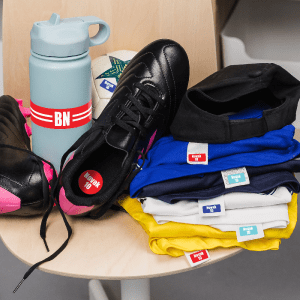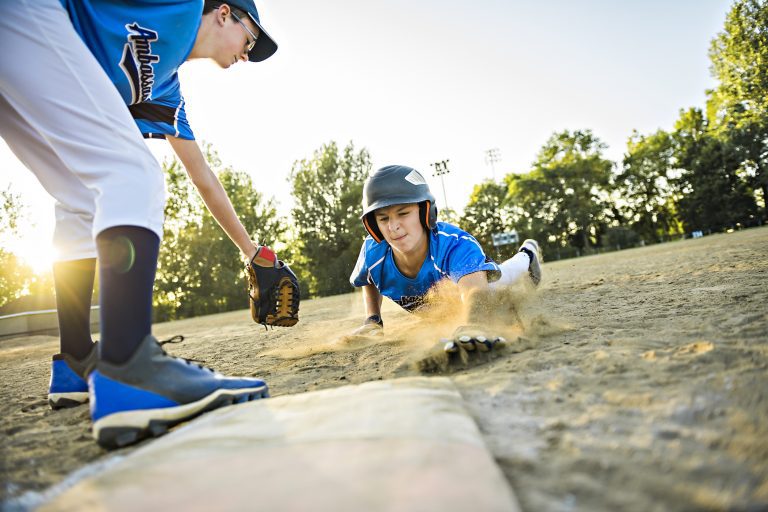Any youth sport coach will tell you that a dirty uniform is a beautiful thing — a sign of true effort and hustle. As the parent, however, your hard work begins after the game, to get that uniform bright and clean again. To help you out, we’ve compiled some tried-and-true ways to keep your child’s jersey and other associated gear in great condition all summer. Here are some field-tested tips for washing baseball and soccer gear.
How to wash a baseball or soccer uniform
Your child’s team-issued uniform likely includes a jersey, hat, pants or shorts, and socks. There may be additional pieces such as a warm-up shirt or other spirit wear.
Without the official uniform, your young athlete can’t go on the field. As such, all pieces should be treated with extreme care during the washing process to avoid any damage, shrinking or discoloring.
Here’s a step-by-step game plan for uniform washing:

- Step 1: Label all uniform pieces with your child’s name and number, to prevent mix-ups with teammates. The Mabel’s Labels Kids’ Sports Label Pack is designed especially for this!
- Step 2: Check the tag for washing instructions. Many jerseys are made from high-tech moisture-wicking fabrics that may be designated as “cold water only” or “hang to dry.” Allow enough time in your laundry schedule for all pieces to air-dry before the next game or practice.
- Step 3: Aggressively pre-treat spots and stains, which could be anything from dirt, grass, sand, clay and turf to Gatorade or post-game ice cream. Generously apply your preferred stain remover product before laundering. You may find it helpful to pre-soak the uniform in the laundry tub, or scrub stain remover into the affected area with an old toothbrush.
A side note about laundry products: the best advice and recommendations come from other sports parents. Once at a tournament in Pittsburgh, I struck up a conversation with a random mom about the difficulties of washing white baseball pants. She happily shared all her trade secrets and laundry hacks — including one I still haven’t tried, which was to take an old-fashioned laundry soap bar, run it over a cheese grater, and add the grated-up flakes to the washload.
- Step 4: After proactively treating the stains, launder the uniform at the appropriate water temperature. Take advantage of any bonus features on your washing machine, such as “pre-soak,” “heavy soil” or “extra rinse”.
Try Laundry Stripping
If you’re finding that a regular laundry cycle isn’t enough to neutralize the sweaty smell, consider taking things to the next level with a strategy called “laundry stripping.” In this process, clean clothes are soaked in a tub with a mixture of water, Borax, washing soda and powdered laundry detergent. After four hours, the clothes should be gently wrung out and put through a final rinse cycle in the washing machine. If you’re seeking a deeper clean, check out this detailed breakdown and instructional video about laundry stripping.
Tips for washing baseball and soccer gear
Here are a few simple steps to keep your child’s important (and expensive!) sports gear in prime condition.
Washing footwear
Take cleats outside and remove all loose dirt and grass from the sole. Wipe dust and mud from the outer surface with a soft cloth. If shoes are wet from dew or rain, remove the insoles and set out to dry in the sun.
How to wash Soccer shin pads
On a busy tournament weekend, help keep bacteria away by spritzing shin pads with a disinfectant spray. A day off with sunny skies is a good choice for more elaborate cleaning. First, use a brush and soapy water to scrub the inner and outer surfaces. Then, soak the shin guards in a mixture of detergent and water for about 15 minutes. Rinse well and set outside in the sun to dry.
Most soccer shin guards can go in the washing machine — although it’s wise to check the tag or the manufacturer’s website to confirm. Place the shin pads in a tied pillowcase or delicates bag and use the gentle cycle. Air dry only — shin pads should never go in the dryer.
How to clean catcher’s gear for baseball or softball
A catcher’s leg guards and chest protector have multiple straps and buckles that aren’t well suited for the washing machine. It’s best to perform a full cleaning before or after the season, where each piece can be manually scrubbed with soapy water, rinsed well and hung outside to dry completely.
Washing baseball and softball helmets
For a traditional two-piece catcher’s mask (similar to an umpire), clean the inner padding with a disposable disinfecting wipe.
Modern goalie-style catcher’s masks frequently have removable padded inserts that attach with Velcro. These pieces can be gently detached from the inside of the helmet and laundered separately in the washer, in a tied pillowcase or delicates bag. Dry outdoors or in the dryer on a low setting.
For batting helmets, the hard outer shell can be wiped easily, but the inner foam is typically glued in and is best left alone. On hot days, air out the helmet post-game so the inner padding is able to dry.
Tips for cleaning smelly baseball and softball gloves
Leather and water don’t mix, so avoid dunking a baseball glove in a washing tub or spraying it with a hose. Instead, manually clean it with a soft brush or towel, as suggested in these expert tips.
Similarly, batting gloves are made from specialized materials and require careful cleaning. Check the specific company’s website for care and maintenance instructions.
How to clean baseball caps
I don’t believe in those plastic cages that supposedly allow a baseball cap to be washed in the dishwasher or washing machine. In my experience, a soaking-wet hat is more likely to lose its shape, structure and proper fit. My best advice is to spot-clean the hat with a damp cloth and place it on a volleyball (or other appropriately sized ball) while drying.
With these simple tips, you’ll be sending your child out on the field looking clean, professional and ready to compete. After the game, remember to praise their dirty shirt or grass-stained pants, as it shows they’re trying their best!
Wondering how to wash hockey gear? Check out these tips!

